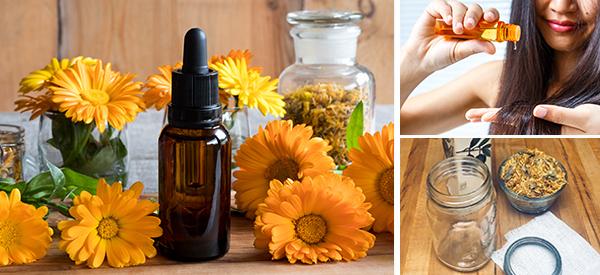
DIY Anti Dandruff Calendula Oil
The calendula flower is a member of the Asteraceae or daisy family. These brightly colored flowers maintain an attractive balance of flower-to-foliage ratio once they reach maturation, and they make a great addition to any landscape or flower garden. But this seductive flower has much more to offer than just curb appeal.
While it is a type of marigold, the calendula flower is ray-like and has far fewer layers than most other marigold varieties. The calendula plant grows to be about 30-50 cm high with oblong leaves, disk-shaped flowers and stems perfect for cutting. calendula has a woody and somewhat musky scent, especially in its concentrated form. The edible flowers are a bit “bitey” when eaten in soups or salads, but the bitterness is somewhat tamed when made into tea. These dazzling flowers can be different shades of oranges and yellow and are native to central and northern Europe. But you can readily find calendula growing in gardens and pots throughout North America and many other places worldwide.
Calendula flower (C. officinalis), also known as “pot marigold,” has been used for centuries to treat dermatological disorders. Calendula plant is used therapeutically for many conditions such as wound healing, jaundice, and blood purification. Pharmacological studies of the calendula plant have detailed the presence of different medicinal compounds like triterpenoids, flavonoids, volatile oil, carotenoids, and amino acids. In addition, the extract of this plant in concentrated levels exhibits multiple pharmacological benefits such as anti-HIV and cytotoxic properties, which means it could be a worthwhile companion to people with certain types of cancers and autoimmune disorders.
You can also find this convenient All-Purpose (First Aid) Salve that contains calendula and other healing herbs in the apothecary.
But for this article, the emphasis is on how to take care of a scalp with dandruff and a few other similar skin conditions by making your own moisturizing calendula oil. You will find the recipe below, but first, let’s have a look-see at what makes this functional flower an exceptional choice for nourishing a dry, flaky scalp.
The Proof Is in the Petals
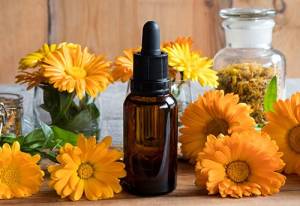 While calendula leaves do have some medicinal properties, most of the scientific research has been conducted using calendula flower heads and petals. And there are several proven calendula benefits for the skin and scalp. For example, calendula is anti-inflammatory, which helps alleviate itching and irritation associated with dandruff and Seborrheic dermatitis (SD), which is pretty much a severe case of dandruff that commonly includes a rash, redness, inflammation and scaly yellow patches.
While calendula leaves do have some medicinal properties, most of the scientific research has been conducted using calendula flower heads and petals. And there are several proven calendula benefits for the skin and scalp. For example, calendula is anti-inflammatory, which helps alleviate itching and irritation associated with dandruff and Seborrheic dermatitis (SD), which is pretty much a severe case of dandruff that commonly includes a rash, redness, inflammation and scaly yellow patches.
SD affects one in three people. A six-week study done by a group of homeopathic clinicians found that calendula mixed with a carrier oil. Calendula is antimicrobial, proven to inhibit various bacterial and fungal strains, including those that cause dandruff. It can even hinder the replication of the herpes simplex virus!
While calendula can help alleviate the root cause of dandruff and SD, it can also soothe and repair the skin. And it makes perfect sense in a world full of synchronicities that nature would charge this pretty flower with the capacity to increase collagen, moisturize skin and decrease tissue damage. Scientists believe this might be due to its antioxidant properties.
Other studies favored calendula to prevent acute dermatitis in patients undergoing irradiation for breast cancer.
How to Make Calendula Herbal Dandruff Oil
Calendula is a mild herb. This simple oil is safe for children and can be applied to other sensitive areas of the skin or the skin of small infants. Here are the steps to make your calendula oil:
You Will Need
- 1-pint size jar
- 1-6×6 piece of cheesecloth
- 1-jar ring (to fit jar used)
- carrier oil (Oils like coconut, almond, jojoba and argan have super nourishing abilities and can mitigate dandruff).
- Enough fresh or dried calendula to fill the jar three-quarters of the way full
- 1-dropper bottle (preferably blue or amber color)
- Measuring cup or container with pouring lip
Step 1.
Gather together your first set of ingredients: Jar, ring, cheesecloth, oil, and flowers.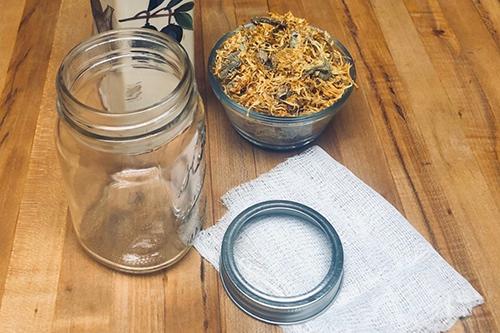
Step 2.
Place enough dried calendula flowers into your pint-sized jar to fill it about three-quarters full.
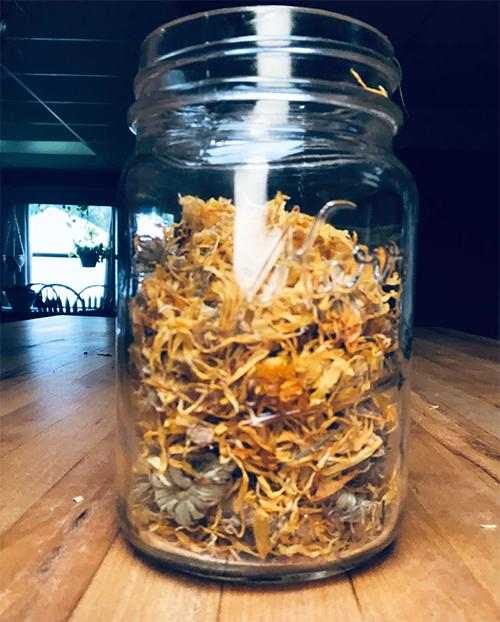
Step 3.
Fill the jar with enough oil to cover the flowers completely.
Step 4.
Cover the top of the jar with your cheesecloth.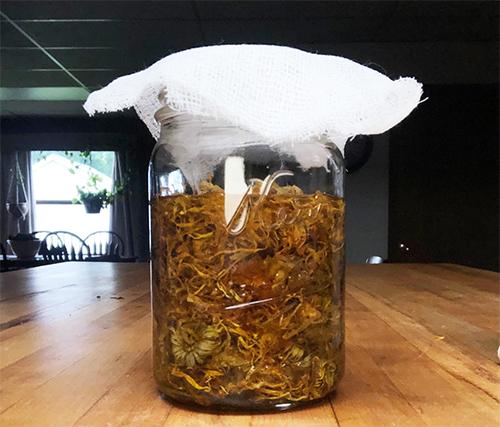
Step 5.
Secure the ring to the top of the jar over the cheesecloth. You can also use a rubber band.
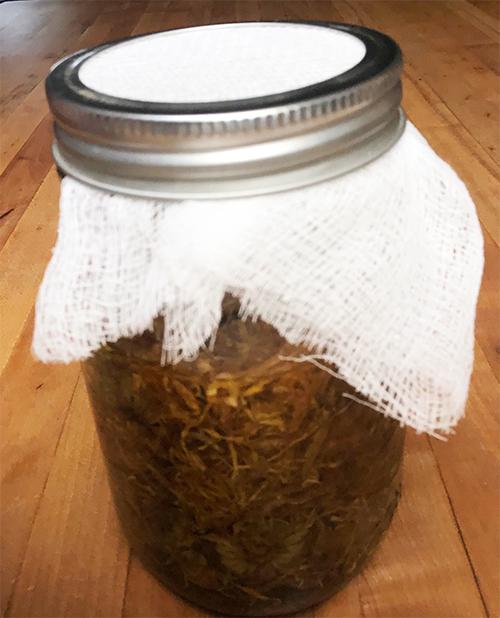
Step 6.
Place the jar in a sunny window to macerate for six weeks.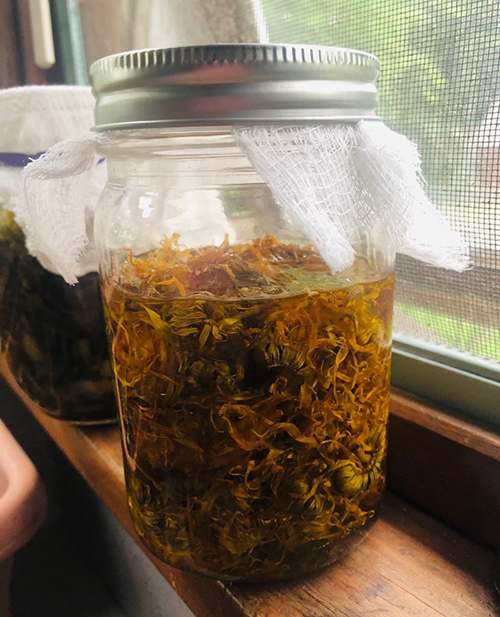
Step 7.
After six weeks, gather your second set of ingredients: your finished calendula oil, dropper bottle, and measuring cup or container with a pouring lip.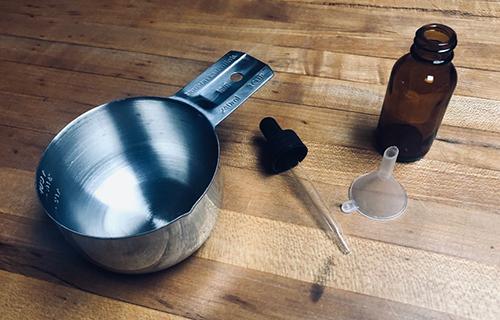
Step 8.
Pour your finished oil into the cup with a lip through the cheesecloth.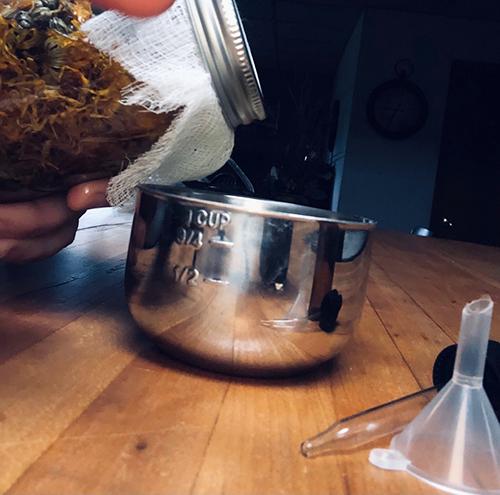
Step 9.
Begin adding the oil to the dropper bottles. You will probably need to use the dropper at first, but can carefully poor it into the bottle when the cup becomes a bit less full. Your bottle may come with a small funnel that will make this process much easier.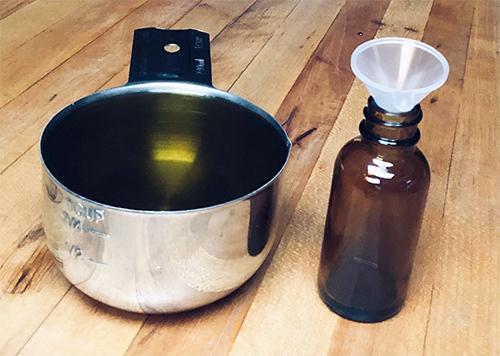
Step 10.
Add a dropper to the top of the bottle and secure. Store in a cool dark place for up to one year.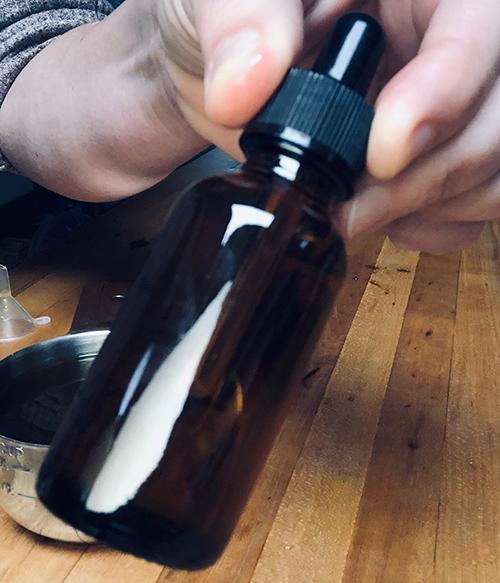
How to Use
- Apply a few drops of calendula oil to your fingertips and rub the oil into the scalp on any dry, flaky, or red patches.
- Let the oil sit for about 20-minutes
- Then wash as usual or without shampoo if your dandruff is from a dry scalp.
- Repeat these steps at least twice a week until you see an improvement or get the desired results.

Added Tips
Here are a few extra tips.
- Fresh flowers will be more potent than dried ones, but they can be hard to find
- You can try mixing some of these other oils or herbs into your oil for a great scalp oil blend: chamomile, chickweed, tea tree, lavender, neem, lemongrass, thyme, rosemary, and patchouli.
- You can mix your oil blend with a bit of coconut oil and leave it on overnight as a deep penetrating scalp treatment. (You will need to cover your head with a shower cap)
- Add a few drops of vitamin E oil to make your oil last longer
**Use caution not to let the oil run down into the eyes, especially if you add other oils such as tea tree, neem, or lavender. If you have never used those oils before, test them on a small patch of skin before adding them to your calendula oil, and make sure they are safe for children before using your mixture for a small child.
LOSING HAIR? Do This For 1 Minute Before Bed To Regrow Your Hair (Video)
How To Make a Powerful Calendula Extract to Keep in Your Medicine Cabinet
DIY Anti Dandruff Calendula Oil
Equipment
- 1 pint size jar
- 1 6×6 piece of cheesecloth
- 1 jar ring
- 1 dropper bottle (preferably blue or amber color)
- 1 Measuring cup or container with pouring lip Measuring cup or container with pouring lip
Materials
- carrier oil Oils like coconut, almond, jojoba and argan have super nourishing abilities and can mitigate dandruff
- Enough fresh or dried calendula to fill the jar three-quarters of the way full
Instructions
- Gather together your first set of ingredients: Jar, ring, cheesecloth, oil, and flowers.
- Place enough dried calendula flowers into your pint-sized jar to fill it about three-quarters full.
- Fill the jar with enough oil to cover the flowers completely.
- Cover the top of the jar with your cheesecloth.
- Secure the ring to the top of the jar over the cheesecloth. You can also use a rubber band.
- Place the jar in a sunny window to macerate for six weeks.
- After six weeks, gather your second set of ingredients: your finished calendula oil, dropper bottle, and measuring cup or container with a pouring lip.
- Pour your finished oil into the cup with a lip through the cheesecloth.
- Begin adding the oil to the dropper bottles. You will probably need to use the dropper at first, but can carefully poor it into the bottle when the cup becomes a bit less full. Your bottle may come with a small funnel that will make this process much easier.
- Add a dropper to the top of the bottle and secure. Store in a cool dark place for up to one year.
Notes
- Apply a few drops of calendula oil to your fingertips and rub the oil into the scalp on any dry, flaky, or red patches.
- Let the oil sit for about 20-minutes
- Then wash as usual or without shampoo if your dandruff is from a dry scalp.
- Repeat these steps at least twice a week until you see an improvement or get the desired results.

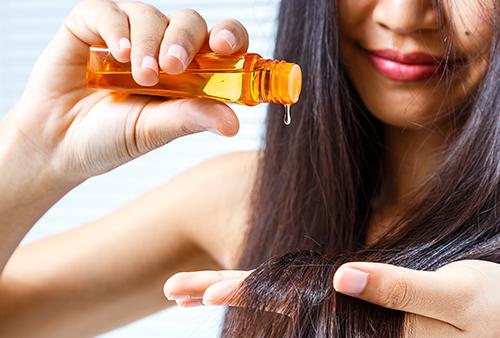


Thank you for this recipe. I see you don’t mention olive oil. Is there a reason for this?
♥️Living with a virus for eternity is something one need to sit down and think. There is a you cure out there for any type of viruses and diseases. So why listen to people who will discourage you and not give you cure. Alternative cure for any type of viruses, diseases and STDS available. Contact Dr Anara for help in ridding out your problem.
1; HSV1 and HSV2
2; Lupus diseases
3; Cancer
4; Human Papilloma virus (HPV)
5; Crohn’s diseases
6; Diabetes
7; Sickle Cell Arnamia
8; Herpes
9; HIV
10; Firbromyalgia.
👇🏽❤️👇🏽❤️👇🏽
https://www.facebook.com/dranara2-100436714985352/
This comment is a scammer!!! Can a site admin delete it? Some people may be tricked into following the link. Leaving spam up isn’t good for your site reputation.
Is it possible to use an organic 100% pure and natural Calendula oil for a base instead of making my own?